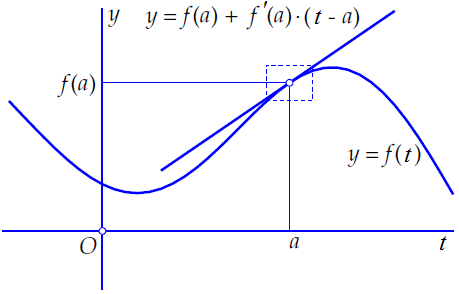Differential equations: Direction field
 Direction fields
Direction fields
Dynamic systems of first-order and first degree are an important class of ODEs. We will see that without performing complicated calculations you can often get an idea about the shape of the graphs of solutions of the differential equation.
The solutions of an ODE of the form \[\frac{\dd y}{\dd t}=\varphi(t,y)\] can be interpreted geometrically as follows: Take a point \(\rv{a,b}\) and suppose that \(y(t)\) is a solution of the ODE whose graph goes through \(\rv{a,b}\). Then the tangent line to the graph of \(y\) at the point \(\rv{a,b}\) is given by the equation \[y=b+\varphi(a,b)\cdot(t-a)\]
Direction field and solution curve
If we draw a small piece (segment) of the tangent line at the point \(\rv{a,b}\), this small line segment will be close to the solution of the ODE going through \(\rv{a,b}\). Such a segment is called a tangent element or line element at the point \(\rv{a,b}\) of the \(t,y\) plane.
Now for a variety of points \(\rv{a,b}\) in \(t,y\) plane, we can draw these line elements. A drawing with a number of these line elements is called a slope field or direction field of the ODE. Usually the points are chosen from a regular grid, but this is not necessary.
By drawing a smooth curve tangent at each point to the line elements, we obtain a so-called integral curve. This is the graph of a solution of the ODE. Such a curve is also called solution curve.
The approach of the solution curve line elements is based on the fact that the graph of a differentiable function, having a smooth pattern near all or almost all of its points, looks more and more like a straight line when we zoom in to the point. That line is the tangent line to the graph at that point.
Below the graph of a differentiable function \(f(t)\) is drawn, as well as the tangent line at the point \(\rv{a,f(a)}\). In the immediate vicinity of this point, the graph and the tangent line can hardly be distinguished from each other.

By way of illustration, the rectangle around the point \(\rv{a,f(a)}\) in the figure above is drawn again below, but enlarged.

The equation of the tangent line at the point \(\rv{a,f(a)}\) is equal to \[y=f(a)+f'(a)\cdot(t-a).\] For \(t\) near \(a\) we have: \[f(t)\approx f(a)+ f'(a)\cdot(t-a).\] This also means that if we know the value of the function and its derivative at a certain value of \(t\), we also know the function value at a small distance \(\delta\) by using the following formula: \[f(t+\delta)\approx f(t)+ f'(t)\cdot \delta\]
The closer we come to\(t\) (or: the smaller the time step \(\delta\)), the better the estimate of the function value of #f# at #t+\delta#.
A direction field of a differential equation of first order and first degree, as well as integral curves calculated using a numerical method, often provide a good impression the solutions and their behavior.
Drag the point \(P\) in different directions in order to see different solution curves.
You can change the settings and render a picture of the new situation by clicking the update button.

Or visit omptest.org if jou are taking an OMPT exam.




